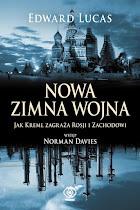A map that tells a story with a happy ending
By Edward Lucas
There is a book in Kaunas, Lithuania's fascinating second city, that I wish could talk.
It's an atlas, published in Germany in 1922, and it is open at the map of Europe. But it is Europe in boundaries that are barely recognisable today, partly showing a world that is lost and partly one that never existed.
The mapmakers have guessed valiantly at the borders of an independent Ukraine. There is heavy red stippling over the tiny statelet of Soviet Belarus - though tantalisingly, there is no legend to show what the cartographers thought was happening there.
There is an independent Crimea, reflecting the brief moment of statehood enjoyed by the peninsula's Tatars before the Red Army crushed the country and sent their leadership into exile.
Further afield, Turkey stretches on into Iraq but does not include Constantinople (as the map calls today's Istanbul). Greece holds Smyrna (today's Izmir).
All three Caucasian republics are shown as independent, with Armenia stretching a long way south, to Ezerum.
It would be nice to talk to the mapmaker about how he made his decisions. Did he try to make the map more up-to-date in those hectic post-war years, only to be frustrated by a skinflint publisher who didn't want to pay for yet more new lithographic plates?
Or was he trying to show what he thought was the likely outcome? I can imagine him saying to himself: "Hmmm, the Soviet Union won't last long - I'll keep all these countries on the map."
But I'd like even more to ask the book about its owners. One was a Lithuanian whose illegible pencil signature - it starts with P - is on the title page. Did he buy it new, I wonder, to celebrate his country's return to the world map?
Perhaps he was an official, or government minister, in one of the republic's early governments, one of those solemn moustachioed men whose grainy photos are usually accompanied with a note showing they died in the Gulag.
Or perhaps he bought it cheaply second-hand, when that map was out of date. I wonder if he looked at the countries already swallowed by Soviet rule and feared that the Balts would be next. Or he may have hoped for it: left-wing intellectuals in the Baltic states, as elsewhere, were fooled by the promise of a workers' paradise.
At some point, the Molotov-Ribbentrop pact line, which secretly divided Europe between Hitler and Stalin, has been pencilled in, rather clumsily.
I'd love to know who did that. Was it in secret, in occupied Lithuania, when the atlas was safely away from prying eyes, maybe buried in a chest in the garden with a pre-war flag and a guerrilla fighter's rifle? Or maybe it was drawn in 1989, when Estonians, Latvians and Lithuanians joined hands in a giant human chain to commemorate the pact's 50th anniversary, kick-starting their struggle to recover independence.
But whatever the book would say about the past, I think it would be glad about the present. It is not imprisoned in a glass box in a dusty museum, but in the town's best café, the Toscana, for every customer to leaf through.
The place sparkles with life; it is owned by a returned émigré (no worries here about the brain drain); the smiling staff are students from the excellent independent Vytautas the Great university.
And the coffee beans are freshly roasted on the spot: in other words, it is just like anywhere in Europe, but a bit nicer. The atlas's previous owners could have dreamt of nothing better.
Thursday, June 15, 2006
A map and a coffee
Subscribe to:
Post Comments (Atom)
























1 comment:
Lovely- I must remember to show you my map of Poland from the same period!
Post a Comment